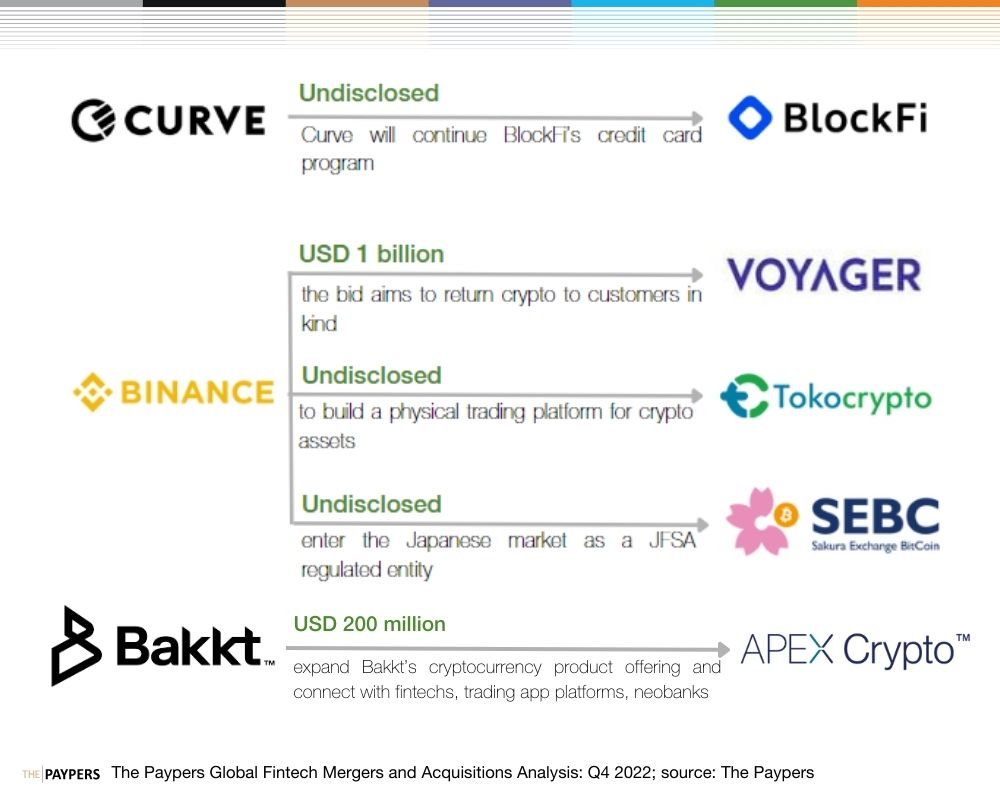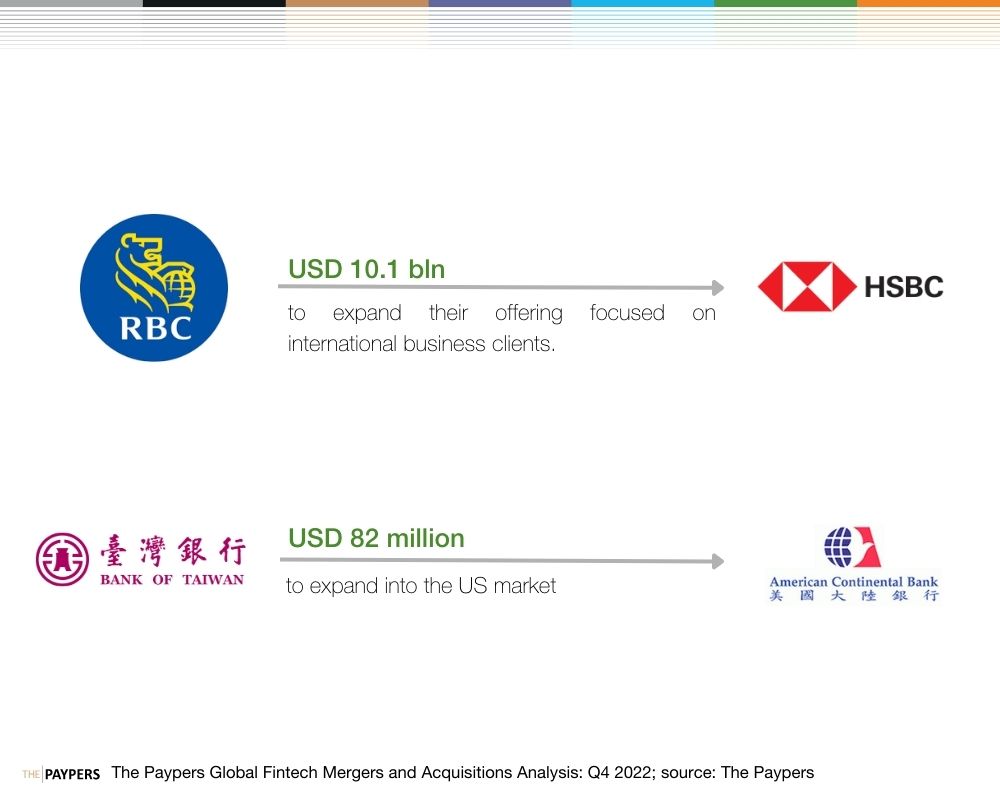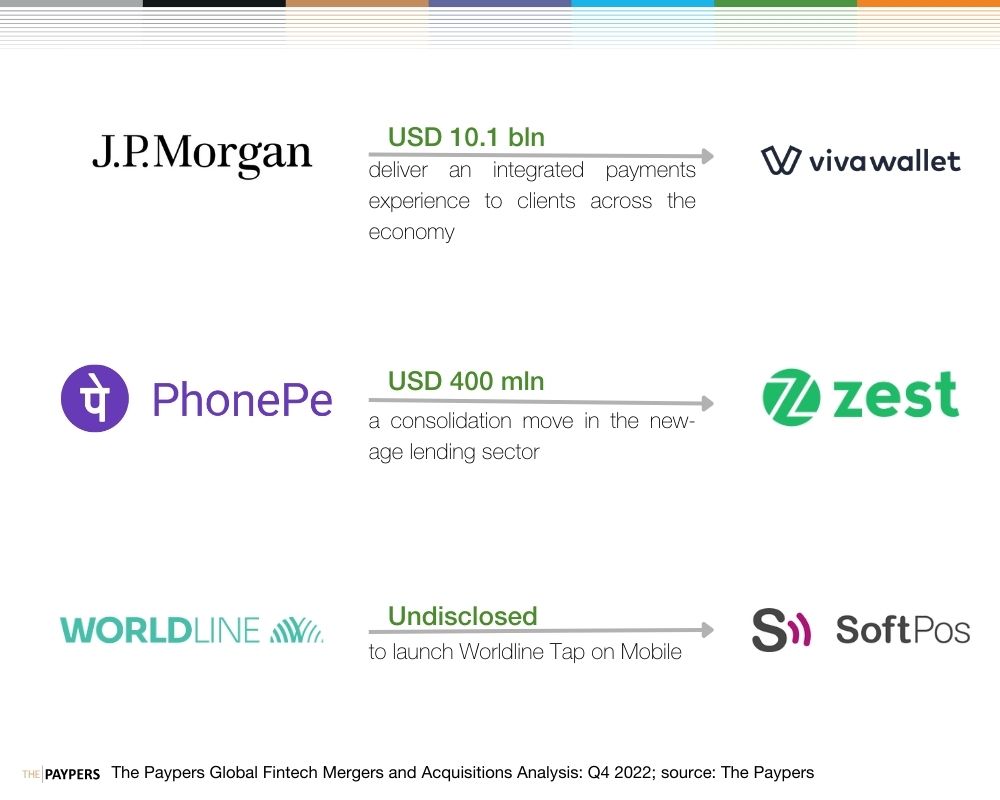Payper’s Global Fintech M&A: Q4 2022

Mergers and acquisitions (M&A) values surpassed record highs set in 2015 (UDD 3.96 trillion) and 2007 (USD 3.67 trillion), pushing companies to speed up their due diligence procedures for most of the past two years . However, after the pace of deal-making slowed in late 2022, the focus is currently on how quickly a deal can deliver expected returns.
Although 2022 was the second busiest year ever for M&A activitywith a total of 1,270 deals, just after 2021 (1,485), the volume of fintech M&A only managed to reach USD 129.6, the lowest level since 2017.
Fintech M&A activity began to slow significantly in the second quarter of 2022. Global investment fell 33% quarter-on-quarter, to the lowest levels since 2020. Also, there was a significant drop in deal volume.
The fintech sector, like the rest of the M&A industry, has been affected by the general economic and investment uncertainty resulting from rising inflation and interest rates, as well as growing concerns over the political and economic climate. Therefore, for the first time since 2018, there was no increase in M&A activity in the fourth quarter to end the year. The number of global M&A deals fell even more in Q4 2022 (USD 719 billion) compared to the startlingly low deal volume in Q3 2022 (USD 735 billion).
Focus on the trends
Businesses must adapt to rapidly changing industries in order to survive. This is why companies are constantly looking to acquire other companies that can provide them with cutting-edge technology and know-how. Today, companies want to expand quickly through acquisitions. Therefore, there is a lot of interest in platform companies that have a large customer base, but are still trying to figure out how to monetize it.
Curve’s acquisition of BlockFi’s more than 87,000 credit card users, for example, was partly motivated by this. If the purchase is successful, the fintech hopes to keep BlockFi’s credit card program going. Customers from BlockFi’s credit card program will not be ported to another centrally held exchange, which is an added benefit of a successful acquisition.
However, BlockFi is just one of the many cryptocurrency companies that were (partially) acquired, because they had trouble raising capital made for easy acquisition purposes. Negative press around cryptocurrencies, especially after FTX’s recent collapse, may have damaged investor confidence and slowed investment, but M&A activity was unaffected.
Furthermore, despite that the number of payment agreements fell by 14% to 113 in 2022 from 132 in 2021, the sector still produced one of the biggest transactions of the year: Thoma Bravo’s deal to buy privately held expense management player Coupa Software for USD 8 billion.
Focus on the crypto industry
Without a doubt, 2022 was a difficult year for the crypto industry. However, despite ongoing market volatility, it continues to be a fertile ground as consumer demand for digital assets remains high.

There has already been some market activity as a result of the wave of insolvencies that emerged in the second half of the year. In December, for example, Binance.US agreed to pay US$20 million to buy Voyager Digital’s customer accounts plus the market value of its crypto assets, which at the time of the announcement was approximately US$1 billion.
To crypto-natives to buy assets out of bankruptcy, as in the aforementioned case, there are three main reasons. One is customer expansionas demonstrated by the agreement between Binance.US and Voyager. Investment in human capital and technological infrastructure is another option. The regulatory framework, licenses and authorizations of a failed target may also be attractive to potential buyers.
This deal aims to expand the user base of Binance.US while providing Voyager’s customers with access to a cryptocurrency-based recovery and liquidity, although there is no guarantee that the sale will receive regulatory approval.
However, this was not Binance’s only M&A move: in the same month, the company also paid undisclosed amounts to acquire Tokocrypto and Sakura Exchange BitCoin. Given that SEBC is a JFSA-registered cryptocurrency exchange, these are both investments in the company’s expansion throughout Asia.
The agreement by Bakkt to buy Apex Crypto for USD 200 million was another significant transaction. In this case, the goal is to increase the range of cryptocurrency products that Bakkt offers and strengthen relations with new customer segments such as fintechs, trading app platforms and neobanks. The Apex Crypto platform also supports a comprehensive user experience while handling any regulatory and licensing requirements associated with investing in cryptocurrency.
Focus on the banks
Almost all mid-market banks in the sector are looking to buy or be acquired. Many banks see an acquisition or a merger as an opportunity to expand their clientele or accelerate the growth of their business.

However, statistics indicate that up to November 2022, only 149 US bank mergers and acquisitions had been announced. That put the sector on track for 162 deals in 2022, down significantly from 206 the year before. The downturn came at a time when US regulators were scrutinizing industry consolidation before approving large acquisitions.
Nevertheless, some notable contracts were signed in 2022. One of these transactions was the purchase of 100% of the issued common capital of HSBC Canada by Royal Bank of Canada for a cash consideration of USD 10.1 billion. In addition, for approximately US$0.8 billion and US$0.7 billion, respectively, RBC will purchase all outstanding preferred shares and subordinated debt issued by HSBC Canada and owned by HSBC Group. The agreement is expected to close at the end of 2023.
Also, to enter the US market, Taichung Commercial Bank decided to buy American Continental Bank for US$82 million. The decision by Taichung Commercial Bank coincides with heightened military hostilities between Taiwan and mainland China in 2022. Some of the biggest technology companies in the world are based in Taiwan, and Washington has encouraged the country’s chip industry to make investments in the United States.
Focus on digital identity and fraud prevention
The level of corporate and geopolitical threats to key infrastructure may suggest that cybersecurity firms should be valued more like defense stocks than technology stocks. Almost every new technical invention that contains sensitive data or communications requires a corresponding cybersecurity innovation to protect that data and innovation.

Small businesses offering highly specialized and sophisticated goods to meet certain cybersecurity needs are flooding the market to satisfy this growing demand, fueling an active M&A climate. New companies are being formed at a rate that is difficult to match through consolidation.
For example, looking at Thoma Bravo’s investment decisions for 2022, it is clear that cybersecurity and fintech have received the majority of the investment company’s capital. Both trends have many years of industry innovation and development ahead of them because they are secular growth trends. Remote work and cloud-based access to digital systems were challenges for many companies that were not prepared. Because of this, identity and access management has experienced rapid expansion in recent years. Thoma Bravo recently acquired ForgeRock, so it’s obvious it wants a piece of the action. (And don’t forget SailPoint and Ping Identity.)
Considering that over two-thirds of e-commerce transactions are platform-based, making markets a potential target for fraud, MANGOPAY’s decision to acquire Nethone was a natural step.
The move followed Advent International’s acquisition of MANGOPAY in April 2022, when it became the company’s new majority investor with the aim of promoting MANGOPAY’s expansion and product offering. MANGOPAY and Nethone are now attempting to create a fraud protection system designed specifically for platforms and marketplaces.
Focus on payment solutions
As consumer expectations and operational complexity increase, the speed of digital acceleration across industry sectors does not appear to be slowing. Due to disruption from fintechs and non-FS organizations, technological capabilities continue to be a key component of corporate initiatives to strengthen market position.

In order to leverage data, increase operational efficiency and speed up transaction processes, it was only natural for a significant portion of M&A to be capacity-driven deals. With the help of M&As, companies can cut down on the outsourcing of services, so that they can improve internal operations and control expenses. It can be especially important when you are facing financial hardship. In addition, product suites can be expanded through acquisitions, enabling companies to serve more customers and increase revenue. This helps improve their value proposition compared to rivals.
Based on these reasons, it should not come as a surprise that Worldline decided to buy a 55% stake in SoftPos.eu, especially considering that it supported the company’s new product launch: Worldline Tap on Mobile. Using the Android application, all merchants can take payments from customers using a smartphone, tablet or business device with just a single tap.
Similarly, PhonePe recently acquired ZestMoney to have immediate access to a ready consumer credit base. In addition, it strengthens PhonePe’s financing strategy – a market that competitor Paytm has already mastered.
The deal between JP Morgan and Viva Wallet was another comparable deal. The bank bought 48.5% of the startup for more than USD 800 million. The financial institution now has access to an omnichannel solution that offers seamless, conversion-promoting and secure ways to process transactions in both the physical and digital worlds, streamline business operations and improve the customer experience.
Conclusions: focus on the future
Fintechs will seek a quick exit due to the macroeconomic climate (higher interest rates, more cautious VC activity, general decline in GDP or full recession). In contrast to the more common options of recent years, which were raising money to fuel growth or a public exit, it will make companies more likely to merge with, or be acquired by, larger peers.
According to a poll conducted by Financial Brand of financial institutions, the top three strategic priorities for respondents were expand data and analytics capabilities, lower operational costs and improve the digital experience for consumers. Fintechs can offer incredibly viable answers to all these problems because they are full of great technical talent and lean operations.
According to the same Financial Brand report, a growing number of traditional financial services companies have experimented with fintech collaborations. Regulatory compliance and procurement are expected to be speed-blocking issues, and they can affect businesses across all industries. However, the foundations have been laid for future cooperation and an increase in M&A during the coming year is still predictable.
About Claudia Pincovski
 Claudia is a senior content editor at The Paypers and works on the Banking & Fintech team at The Paypers. She has a bachelor’s degree in journalism and is very passionate about exploring the latest news on financial inclusion, financial literacy, digital banking and open finance. Claudia is a diligent researcher, a diligent editor and an active advocate for diversity and inclusion.
Claudia is a senior content editor at The Paypers and works on the Banking & Fintech team at The Paypers. She has a bachelor’s degree in journalism and is very passionate about exploring the latest news on financial inclusion, financial literacy, digital banking and open finance. Claudia is a diligent researcher, a diligent editor and an active advocate for diversity and inclusion.
























